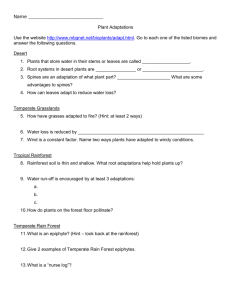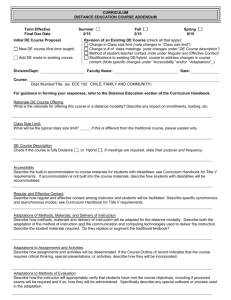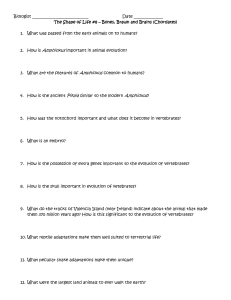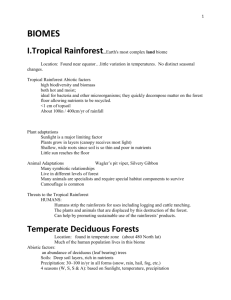ECOLOGY
advertisement
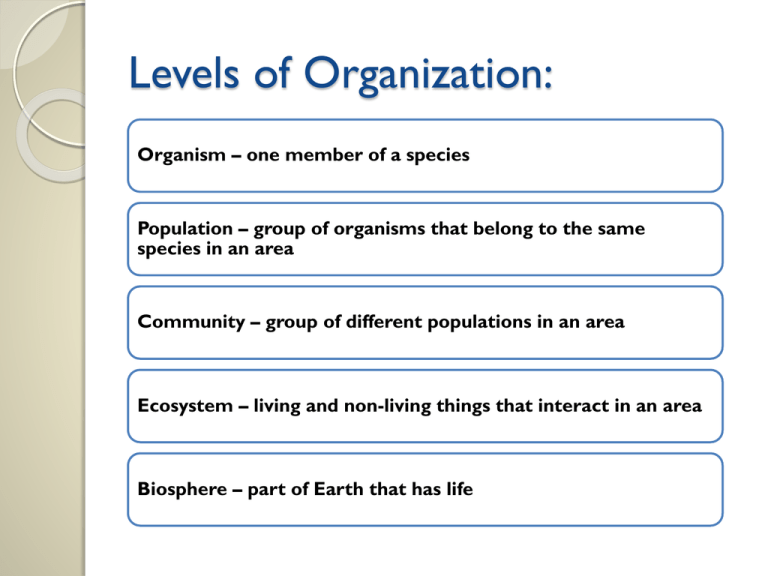
Levels of Organization: Organism – one member of a species Population – group of organisms that belong to the same species in an area Community – group of different populations in an area Ecosystem – living and non-living things that interact in an area Biosphere – part of Earth that has life Organism Population Community - Habitat – where an organism lives and gets its needs (example: food, air, shelter, etc.) Environment – all living/non-living things that an organism could interact with Biome – group of ecosystems with same climate, same dominate plants/animals Figure3-2 (page 64) Ecosystems and Communities There are MANY different kinds of ecosystems found throughout the world. Biome: •Large geographical area that has a climate and certain species of distinct _______ plants and animals. •Identified •There by the dominant plant life. are terrestrial (land) and aquatic (water) ecosystems. Climate: Determined by: •Absorption of sun and energy (temperature). •Movement of air and water currents. •Latitude – Polar cold and dry Equator warm and wet •Land Masses •Ocean currents Cold on West Coast, warm on East Coasts Soil: •Organized mixture of organic, water, air, and organisms Fragmentation •____________ -physical break-up of rock (Ex – Weathering and Chemical) humus •____________ decomposed organic matter in the soil. • texture water holding capacity • High in the forests, low in the deserts Terrestrial Biomes Tropical Rainforest Tropical Rainforest: •Found • equator along the __________________ Temperature, rainfall (250cm/yr), humidity •Little humus and organic litter, poor soil. •Very high ___________________ biodiverstiy Animal Adaptations •Specialization • among organisms biodiversity Threats •Deforestation • Agriculture - was 20% of Earth’s surface, now ONLY 7% Temperate Rainforest Temperate Rainforests: •50º • – 60º N Latitude rainfall, moderate temperature •Pacific •Plant NW life – redwoods, spruces Temperate Deciduous Forest Temperate Deciduous Forests: •30º – 50º N Latitude •Trees drop _________ leaves in the fall to save energy • Seasons •Rich layer of humus •Fertile soil •N. America, Europe, Asia Forests of maples, beeches, oaks….. Plant Adaptations •Broad, thin leaves with large surface areas for maximum light absorption • Seeds and underground stems survive winters Animal Adaptations •High •Most •Some Biodiversity birds migrate to warmer climates mammals drastically reduce their metabolic rate in the winter (hibernation) Taiga Taiga: •Northern coniferous forests just south of the Arctic Circle •Long cold winter 6-10 months • Short growing seasons enhanced by constant sunlight. •Snow precipitation Plant Adaptations • Conifer leaves are thin and waxy to retain water • Cones protect seeds Animal Adaptations • High Biodiversity in the summer • Birds migrate south in winter • Animal fur is thick and insulated Tropical Savannas Tropical Savannas: •Around the equator grasses •Main vegetation _________________ • Low precipitation and moisture •Frequent fires, and herbivores Plant Adaptations •Large underground root systems to survive the dry season AND fires • Thorns and sharp leaves to protect from herbivores Animal Adaptations •Large herbivores specialized for different levels of vegetation •Migratory •High number of carnivores Temperate Grasslands (Prairies, Steppes, Pampas) Temperate Grasslands (prairies, steppes Pampas): inland •_____________ part of continent •Main vegetation grasses •Very fertile soil, little rainfall •Was 42% of Earth’s surface now only 12% fires •________________ common Plant Adaptations •Grasses are perennials survive year to year •Few trees can survive •Root system is dense to protect from droughts Animal Adaptations •Few large herbivores •Underground Burrows Threats •Agriculture (wheat, corn, rice) •Overgrazing soil erosion Deserts Deserts: •There •< are many kinds of deserts. 25 cm rainfall per year •Soil is rich in minerals BUT little organic matter •Some Rainshadow effect produced by ______________________ mountains •Rain falls on the winward side of _____________ •Dry air is swept over the leeward side Plant Adaptations •Thick, fleshy stems with wax covering •Spines to protect against predators •Sudden growth spurts Animal Adaptations •Estivation summer sleep •Nocturnal •Absorb water from food. Threats •Increasing residential areas •Recreational vehicles Tundra Tundra: Permafrost •_____________ permanently frozen layer of ground 6 in below the surface •Dotted with pools of water lots of insects •Treeless Plant Adaptations •Mosses and lichen covered rocks •Short and woody plants •Reproduce quickly in brief summer Animal Adaptations •Migratory birds •Reindeer and caribou move to find food •Small rodents burrow underground Threats •Oil removal and transportation •Land easily damaged and slow to recover
